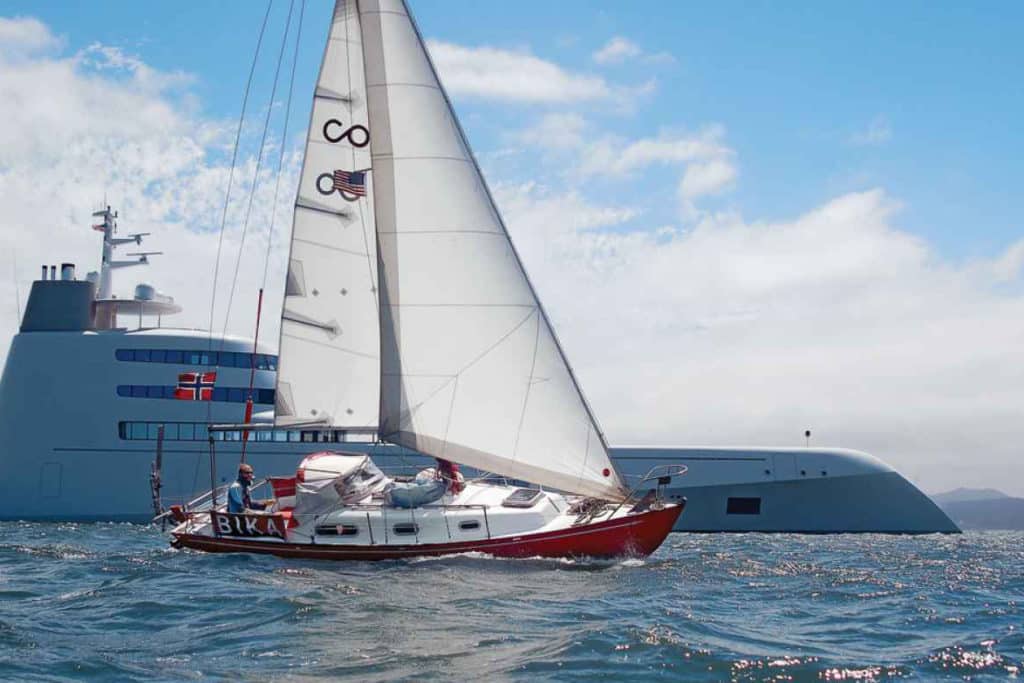
For a boat to become legendary, it doesn’t have to be particularly fast or of groundbreaking design. It only needs that special spark that captures the sailing world’s hearts and minds long enough for it to go down in history. A number of boats with that quality come quickly to my mind—the S&S 34, Flicka 20, Swan 38, Valiant 40—but none holds the same place in my memories as the Contessa 26.
I grew up reading of feats accomplished aboard Contessas by Tania Aebi, Brian Caldwell, and John Kretschmer, so when the Australian adventurer Jesse Martin asked if I’d like to deliver his Contessa 26 from Grand Bahama, in the Bahamas, to Panama and through the Canal, I jumped at the opportunity.
The Contessa 26 was drawn up in 1965 by Jeremy Rodgers, who’d built Folkboats for a number of years, and David Sadler, who had ideas on how to improve the design. They took the classic Folkboat, modified the keel, added more sail area forward for racing performance, changed the layout and deck structure, and built it of fiberglass instead of wood. Four decades later, the popular and widely loved vessel is still safely taking sailors to the far reaches of the globe.
Right away, the Contessa 26 proved itself a strong, seaworthy vessel. It performed well in the Round Britain and Ireland Race and the OSTAR solo transatlantic race, but the brave little boat really became famous when 18-year-old Tania Aebi chose the design for her solo circumnavigation in 1985 and her adventures in Varuna were published in Cruising World. In 1996, Brian Caldwell sailed a Contessa to become the first to circumnavigate under the age of 21.
The Contessa 26 is good-looking, with low freeboard and a narrow beam. For such a small boat, it has a large cockpit, which is nice for having guests aboard and daysailing but a potential danger when filled with water at sea. When sailing, the Contessa heels over quickly, but it soon steadies up and can carry full sail in up to 20 knots of wind.
It doesn’t take much wind to get the boat moving, and it can comfortably make 120-nautical-mile days on passages. After sailing the boat upwind for 300 miles through the Bahamas, I’ll admit that its upwind performance isn’t impressive, but it makes up for it with its ability to survive almost any storm.
The single-spreader sloop rig could easily be converted into a cutter with running backstays and an inner forestay for offshore performance and safety. On some boats, the halyards and reefing lines have been led aft to the cockpit for easy handling. For those who prefer to work forward at sea, the wide side decks and ample handholds permit safe passage to the foredeck.
Down below, the boat has a V-berth forward and a small head and hanging locker aft of that. A small galley and navigation table are positioned aft of the main bulkhead, and two sea berths complete the accommodations. There’s no standing headroom below, which can get old after a few days locked up in the cabin at sea, and the poor air circulation could benefit from added vents, but the boat has everything a singlehander really needs for long-distance voyaging.
Jeremy Rogers built about 350 Contessa 26s in the United Kingdom, and another 400 were built by J.J. Taylor in Canada. At listed prices from $10,000 to $15,000, used boats are an affordable option for sailors who want to safely head offshore on a budget.
CONTESSA 26
LOA 25′ 6″ (7.77m.)
LWL 21′ 0″ (6.40m.)
Beam 7′ 6″ (2.29m.)
Draft 4′ 0″ (1.22m.)
Sail Area (100%) 304 sq. ft. (28.2 sq. m.)
Ballast 2,300 lb. (1,043 kg.)
Displacement 5,400 lb. (2,449 kg.)
Ballast/D .43
D/L 260
SA/D 15.8
Water 10 gal. (37 l.)
Fuel 11 gal. (45 l.)
Engine Various
Designer David Sadler/Jeremy Rodgers
Ryan Langley is a 19-year-old adventurer, sailor, writer, and musician from Port Angeles, Washington.








